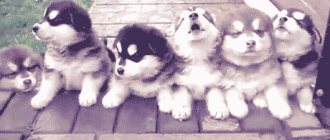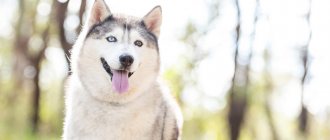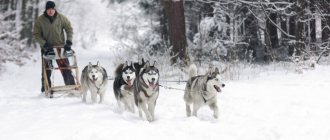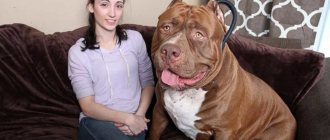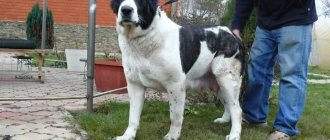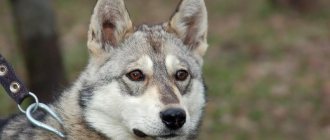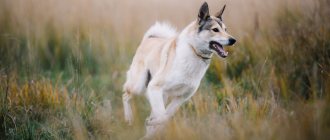In Russia, as well as a number of other countries, there is an increase in the demand for dogs of northern breeds. They tolerate harsh climates more easily and adapt to the new regime faster than others. One of these breeds that is in good demand today is the Yakut Laika. The homeland of these dogs is Yakutia. Animals of this breed have thick, dense hair, which allows them to sleep right in the snow. Thanks to their flexible nature, huskies easily find a common language with people. They are perfect for both hunters and ordinary people. After all, dogs have excellent working qualities in their blood, because of which the pet will become the best assistant for its owner both on the hunt and in everyday life.
Origin of the breed
The breed was bred in the 17th century, the homeland of huskies: Nizhnekolymsk region of Yakutia, beyond the Arctic Circle. Translated from the local dialect, the name is translated as “Yakut dog”. The first researchers: Yokhelson (19th century), Vladimir Dyachkov, German Arbugaev (1998). The standard was officially approved in 2005 by the Russian Canine Organization. The first purpose of dogs is deer hunting, then sled riding. With an active lifestyle, he is fed every day, during rest - 1 r every 2 days, in order to avoid gaining excess weight.
Character of the Yakut Laika
The Yakut Laika is a smart dog, focused on constant interaction with the owner and members of his family. The level of aggression in the breed is minimal, so feel free to bring the “Yakut” into a house where there are small children - this four-legged fidget will certainly make friends with them. By the way, the sociability of Yakut Laikas extends not only to people: in a group of their own kind, the nimble “northerners” also do not shy away and quickly find contact with all members of the group.
In working circumstances (hunting, riding), the breed is quite independent and capable of making its own decisions. Do not confuse this character trait with stubbornness: it is not typical for animals to act contrary to a person’s order, therefore the dog’s personal initiative manifests itself only where the owner’s prohibitions cease to apply. The Yakut Laika is not a breed for a passive owner. To truly experience life, a dog must work. And it doesn’t matter so much whether it’s moose hunting, skijoring or sled walking. Having not given their all physically, the “Yakut” gets bored, falling into apathy, or vice versa – demonstrating destructive behavior.
Most sources describing the characteristics of the breed focus on the docile nature of its representatives. In this regard, potential owners have a not entirely correct impression of Yakut huskies as obedient and naturally intelligent pets. In fact, the “northerners” are capable of destructive cunning tricks, and if they are not stopped in this, they can go far in their sabotage. At the same time, the breed remains extremely intelligent and quickly draws conclusions from any situation, which greatly facilitates the educational process.
Description of the breed
Beautiful appearance is the husky’s trump card. Fluffy long hair, powerful paws, and a slender physique give the dog a special charm. Let's consider the main parameters of appearance:
| Appearance | Characteristics |
| Head | Proportional to the size of the dog, the skull is round in shape, slightly elongated. High forehead, clear stop (the transition area from the forehead to the muzzle). |
| Eyes | Wide or straight set. The shape is almond-shaped, there is no convexity or deep planting. Color: black, brown, can be of different colors: one is brown, the other is blue. Dry, pigmented eyelids of a dark color, identical to the shade of the nose. |
| Muzzle | Wide, voluminous, short. |
| Ears | Broad at the base, set high, triangle shaped, thick, erect or semi-erect. They fold back while moving. |
| Nose | Round, black or brown, with wide nostrils. |
| Lips | Well pigmented, dry, dense. |
| Cheekbones | Cheekbones are moderately expressed. |
| Teeth | White, small, strong, smooth. Scissor bite, incisors not strictly aligned. Teeth wear down as you get older. |
| Neck | Cheekbones are moderately expressed. |
| Body | Muscular, large, rounded ribs. The top line is strong, pronounced withers, strong and level back. Wide and long loin. |
| Tail | In a semi-ring, thrown over the back, set high. |
| Paws | The forelimbs are parallel, strong, muscular, and developed. Shoulders set obliquely, elbows tightly pressed. Short pasterns, straight forearm. The hind limbs are distinguished by strong bones. Powerful thighs, medium-length shins. The paws are balled up, with dark pads and claws, and fur appears between the toes. |
The dog's movements are elastic, energetic, fast, canter. The skin is thick and without dampness.
The breed is not suitable for people leading a sedentary lifestyle or homebodies. It requires constant walking, active training, and walks in the fresh air.
How to choose a puppy
Before buying a Yakut Laika puppy, think carefully: will you be able to provide this special dog with comfortable conditions and a lifestyle? If you don’t have enough time and patience for this, it’s better to get a dog of a different breed, a simpler one. Moreover, a purebred Yakut calf is not cheap at all - about a thousand dollars . Of course, in the North you can buy a puppy cheaper, but it will be a working dog, not a show dog.
Yakut Laika puppies should go to people who understand and appreciate the breed
There are several points that it is recommended to pay attention to when choosing a puppy:
- on the head - it is special among the Yakuts, with a very high forehead and a sharp stop;
- on the eyes - in this breed they often have a black edging, a puppy with bright blue irises will remain blue-eyed, and the gray color will change to brown as it grows;
- on the paws - extremely collected and strong, the skin on the pads is harder than that of other dogs, and the thick hair between the toes helps not to fall into deep snow;
- on wool - thanks to the special wool, the body completely retains its warmth even in 50-degree frost, the wool is unique in density, when you stroke it, your hand immediately becomes hot.
The blue eyes of the little Yakut Laika are incredibly beautiful
Pros and cons of the breed
- appearance;
- adaptability to frost, low temperatures;
- agreeableness;
- friendliness;
- gets along well with children;
- good health;
- adequacy;
- devotion, fidelity.
- needs constant walks;
- not resistant to heat;
- tendency to obesity, overeating;
- loves to dominate.
A dog yearns without its owner, if kept in an apartment, it can howl in sadness alone.
Appearance
The Yakut Laika dog breed is a strong, muscular, well-built and at the same time compact, high-legged four-legged dog . Visually, the dog looks very massive, without any hint of a “damp” build. The rather harsh appearance is emphasized by thick, coarse fur, which allows the husky to work tirelessly in harsh conditions. When in an unfamiliar environment, the dog behaves with restraint, more friendly than wary. The characteristics of the breed describe it as a working and very faithful dog with a keenly developed sense of guardianship over the pack (family). If necessary, the Yakut Laika fiercely guards the owner and his property.
Males and females differ visually; they are stronger, wider and more restive. The female has a softer expression on her face, but her character is in no way inferior to that of the male. The breed standard provides a clear framework within which growth varies:
- Males : optimal height 56 cm; permissible height 55–59 cm.
- Females : optimal height 55 cm; permissible height 53–57 cm.
The weight of an adult dog is from 20 to 23 kg. You need to understand that dimensions are not the main point of the exterior; proportions are much more important:
- The length of the body is 10–15% greater than the height at the withers.
- The length of the skull from the occipital protuberance to the nose is 40% (or slightly less) of the height.
- The length of the facial part is approximately equal to 38–40% of the length of the skull from the back of the head.
- The height of the front paws is 52–54% of the height.
Inexperienced dog lovers can rarely identify dogs from the Laika breed line without making mistakes. The four-legged dogs are often confused with Malamutes or Siberian Huskies. The main differences between the Yakut Laika and Husky in exterior are physical strength, tail set, head size, color and shape of the eyes. Siberian Huskies are sled dogs capable of carrying small loads over a short distance, but as quickly as possible. The Yakut Laika is a hunting dog and despite being distantly related to the sledding breed lines, they are much inferior to the Husky in sledding.
Nutrition
Laika is unpretentious in food - it needs a smaller portion than other hunting breeds. Natural food should include the following products:
- beef;
- marine fish;
- oatmeal;
- rice;
- millet;
- fresh vegetables (carrots);
- dried fruits;
- bones;
- vitamin supplements, minerals.
There must be free access to clean drinking water. It is not recommended to feed your dog dry balanced food - it is used as a reward for completing a command. It is prohibited to treat your pet:
- smoked meats;
- sweets;
- spices, seasonings in food;
- sour milk.
To cleanse the gastrointestinal tract, it is recommended to carry out fasting days: give the dog crackers and plenty of water.
Nicknames
When choosing names for a pet of this breed, you can focus both on the characteristic features of a particular pet, the properties of its disposition, behavior, and use a list of ready-made nicknames. Thus, the following nicknames are recommended for female Yakut huskies: Aurora, Storm, Veya, Blizzard, Gerda, Thunderstorm, Dymka, Ice, Oton (berry - Yakut), Polar, Purga, Siberia, Snezhnaya, Taiga. For male dogs, the following names are chosen: Altai, Arctic, Bars, Buran, Viking, Gray, Ghost, Gray, Grey-haired, Toros, Tungus, Fog, Cold, Storm.
The nicknames of Yakut dogs, like Yakut names in fact, are of a unique nature and are considered to protect the bearer from external threats and evil eyes.
Health
Yakut Laikas have a tendency to develop eye diseases: tearing, redness, and the appearance of pus. Pay attention to alarming signs and symptoms so that you can take your dog to the vet in a timely manner. Once a year you need to visit a doctor for prophylaxis, treat it for skin parasites and worm it. It is important to get vaccinated according to the calendar against the following diseases:
- plague;
- hepatitis;
- enteritis;
- rabies;
- leptospirosis.
Before vaccination, the animal must be examined by a veterinarian.
Conditions of detention
Since the homeland of Yakut huskies is the Far North, their body is best suited for living in cold conditions. Their thick, long coat is excellent for severe frosts, preventing dogs from freezing even when they sleep in the snow. Therefore, huskies have a hard time withstanding the heat, feeling great in cool weather. Living in a stuffy city apartment is contraindicated for them. The best place to keep such dogs is a spacious open-air enclosure or kennel, from which the husky can freely get out and walk around the local area, enclosed by a high fence.
A prerequisite for the normal maintenance of pets is regular moderate physical activity. During a walk, a Laika can run either alone or next to its owner, go down and up an inclined surface, and perform the “fetch” command. Dogs provide irreplaceable assistance during hunting, enthusiastically pursuing game.
Frequent illnesses and problems
Since the breed was bred almost naturally, the representatives are distinguished by good health. It is important to adhere to a diet and care regimen: a lack of microelements leads to bone deformation in childhood. Laikas are prone to the following diseases:
- eczema, dermatitis;
- oncology;
- gastrointestinal disorders;
- hip dysplasia;
- retinal atrophy;
- glaucoma;
- cataract;
- inflammation of the third eyelid.
If the pet is hot, skin problems appear; in old age, deformation of the joint pocket in the paws and the head of the bone is possible.
The Yakut Laika is distinguished by its calm and friendly disposition. It is easy to train; there is no need to use the whip method - the dog understands all commands, thanks to its developed intelligence. This is a loyal friend and an excellent hunter who loves long walks in the fresh air. Does not tolerate heat, it is difficult to take root in apartments. Space and cold are two of this breed’s favorite things.
Dogs can fall in love
When a dog comes into contact with people or other dogs, oxytocin, the love hormone, is released in its brain, this process is identical to what happens in the human brain when hugging or kissing.
The largest dog that ever lived is the English Mastiff.
The English mastiff Zorba, born in 1981, was the largest dog in history. Its mass was more than 155 kg, and its length from the tip of its nose to the tip of its tail was 251.5 cm.
A dog is the first animal to orbit the Earth
Laika became the first living creature to orbit the Earth. Her flight on Sputnik 2 took place in 1957. Although she herself died during the flight, her daughter, Pushinka, gave birth to 4 puppies from the terrier Charlie, whose owner was US President John F. Kennedy.
Application
For centuries, the Yakut Laika has been an assistant to the family and its full member.
And now the breed has not lost its versatility:
- These are sled dogs. They are smart, obedient, hardy. They are not afraid of frost.
- YAL - hunters. They can be trained for any animal: fur-bearing, ungulate. They are not afraid of bears and moose.
Due to their friendly nature, Laika guards are bad. They can only warn the owner by barking, but will not attack uninvited guests. Moreover, aggressiveness is considered a disadvantage of the breed.
Yakut huskies are easy to train and run in harnesses. Freestyle, frisbee, general course - they master everything quickly. After 9 months, you need to get used to physical activity. The main thing in education is firmness. Cruelty is prohibited. From such an attitude, the dog loses its qualities, becomes angry and disobedient.
Mating
You can’t breed a female during her first heat – it’s too early. The first mating is optimal at the age of about two years; this applies to both females and males. Mating too early can negatively affect the health of the mother and her puppies.
Dogs are not fed before mating, but they must be walked; it is optimal to introduce the animals on neutral territory, and the mating itself is on the territory of the male dog; this is done on the 11-15th day of estrus.
Important! For a 100% result, mating should be repeated after 24-48 hours.
Hunting
Yakut Laikas have been bred for a long time in regions with a mild climate, which has had a detrimental effect on the working skills of the breed. Aboriginal dogs are still used to this day to hunt large game in Yakutia. You need to understand that a puppy from working parents will do its job better than a puppy from a show-class nursery.
For hunting, heredity and proper raising of the dog are extremely important - adequate feeding, space, long, free walks and training from early childhood. Working dog puppies go out into the fields when they can't work, but they watch their parents, practice tricks on their siblings, and this experience is priceless.
Yakut Laikas are actively used for autumn hunting. The fishery focuses on bears and adult moose. In some areas, young dogs are actively trained to search for elk. A trained dog will not only work, but also search for the animal, which significantly saves hunters’ time.
Laikas work in packs (4-6 or 6-8 dogs), at the beginning the dogs disperse and walk approximately in a line; when they smell the animal, they begin to run and close together. During the chase, the four-legged animals run through the bushes, often stepping on sharp branches or hitting rocks. Endurance, passion and strong paws Yakut Laikas are designed to overcome just such obstacles.
Note! Purebred Yakut huskies look high-legged, which is due to the need to run through the bushes. Short dogs get stuck in bushes or get wounded on their faces, which takes them out of the work process.
